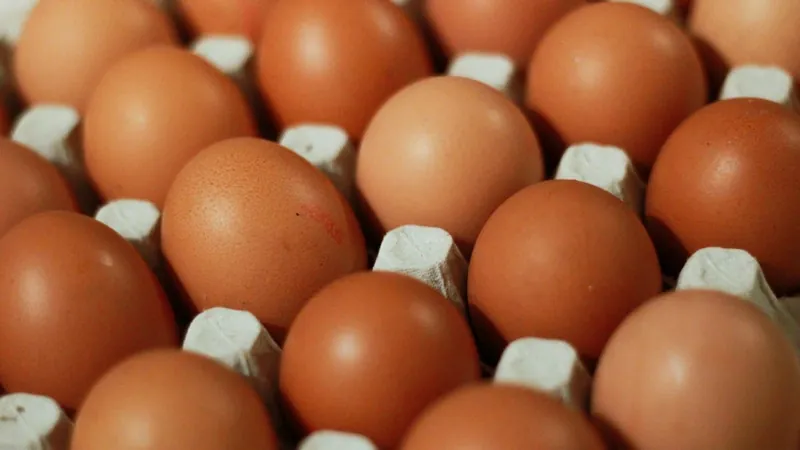
Yellow Fever's Alarming Resurgence: Can Germ-Free Egg-Based Vaccines Save the Day?
2025-09-05
Author: Ming
Yellow Fever: A Shadow of Its Former Self?
Once considered under control, yellow fever is now making a startling comeback, and the numbers are staggering. With existing treatment gaps hindering eradication efforts, researchers are turning to innovative solutions, particularly germ-free egg-based vaccines.
Rising Yellow Fever Cases: The Vaccine Dilemma
In the first half of 2025, the World Health Organization (WHO) reported around 212 yellow fever cases, culminating in 85 deaths across Bolivia, Brazil, Colombia, Ecuador, and Peru. As yellow fever remains endemic in tropical regions of Central and South America and Africa, a nationwide emergency was declared in Colombia after 34 fatalities were recorded in April alone.
The WHO attributes this resurgence to increased sylvatic transmission cycles—natural processes where pathogens spread primarily among animal populations, including mosquitoes. The more these cycles proliferate, the greater the risk of human infection when bitten by these virus-carrying mosquitoes.
The Deadly Nature of Yellow Fever
Catherine Caulfield, CEO of Irish vaccine innovator Ovagen, elucidates that yellow fever is an acute viral hemorrhagic disease, often leading to severe bleeding and fatal outcomes. Many infected individuals experience high fevers and extensive damage to vital organs like the liver and kidneys. A yellowing of the skin and eyes, known as jaundice, can also arise—hence the name yellow fever.
Current Vaccines: Costly But Effective
Sanofi's YF-VAX is the most recognized yellow fever vaccine, produced by culturing a weakened strain of the yellow fever virus in chicken embryos. This vaccine prompts a robust immune response, with just one dose providing lasting protection. However, it comes with a hefty price tag of $220 to $250, making it less accessible for people in endemic areas.
Seeking Affordable Solutions with Germ-Free Egg Technology
As cases continue to surge, Ovagen is pioneering a shift in vaccine production by introducing germ-free egg technology. This method promises immediate scalability and reduces environmental impact, ensuring faster production at lower costs. "We are aiming to increase viral yield per egg, thereby offering affordable options for low-income nations and enhancing public health resilience," Caulfield elaborated.
Understanding Germ-Free Eggs
A germ-free egg is devoid of all bacteria, crafted in a sterile environment where chickens are kept in pathogen-free conditions. Measures like air filtration and sterilized feeding supplies are employed to maintain this biosafety, eliminating the need for antibiotics traditionally used in egg-based vaccine production. This innovative approach not only reduces the risk of antimicrobial resistance but also significantly enhances vaccine yield and cost-efficiency.
Game-Changing Advantages of Germ-Free Vaccine Production
The implications of this research are profound; germ-free eggs can produce up to 7,600 doses of vaccine from one egg, compared to just 300 to 400 doses from conventional methods. Ovagen’s research validated by the Pirbright Institute showcased that their germ-free eggs could yield 1,350 times more of the yellow fever virus strain than standard specific pathogen-free eggs.
In a world grappling with a deficit of 60 million vaccine doses, Ovagen's method drastically reduces the required egg count from over 140,000 to fewer than 8,000, cutting costs and reliance on antibiotics.
Parallel Solutions: Island Pharmaceuticals' Galidesivir
In tandem with vaccine innovation, Australian firm Island Pharmaceuticals is advancing its antiviral drug Galidesivir to combat viral infections, including yellow fever. This compound mimics adenosine, disrupting the virus’s ability to multiply and causing significant structural changes that inhibit its pathogenicity. Although trials faced delays in 2021, Galidesivir is now on the path to potential approval, which could also extend to yellow fever.
Public Health Under Threat: The Urgent Need for Strategies
Despite notable victories in vaccine effectiveness over the years, recent budget cuts in the U.S. have jeopardized further progress in infectious disease research. The gains made in reducing yellow fever deaths by 99% are now at risk, as warned by WHO Director-General Tedros Adhanom Ghebreyesus.
With yellow fever's resurgence threatening public health in South America and Africa, innovative solutions like Ovagen's germ-free vaccines may be the critical breakthrough needed to combat this deadly disease.


 Brasil (PT)
Brasil (PT)
 Canada (EN)
Canada (EN)
 Chile (ES)
Chile (ES)
 Česko (CS)
Česko (CS)
 대한민국 (KO)
대한민국 (KO)
 España (ES)
España (ES)
 France (FR)
France (FR)
 Hong Kong (EN)
Hong Kong (EN)
 Italia (IT)
Italia (IT)
 日本 (JA)
日本 (JA)
 Magyarország (HU)
Magyarország (HU)
 Norge (NO)
Norge (NO)
 Polska (PL)
Polska (PL)
 Schweiz (DE)
Schweiz (DE)
 Singapore (EN)
Singapore (EN)
 Sverige (SV)
Sverige (SV)
 Suomi (FI)
Suomi (FI)
 Türkiye (TR)
Türkiye (TR)
 الإمارات العربية المتحدة (AR)
الإمارات العربية المتحدة (AR)